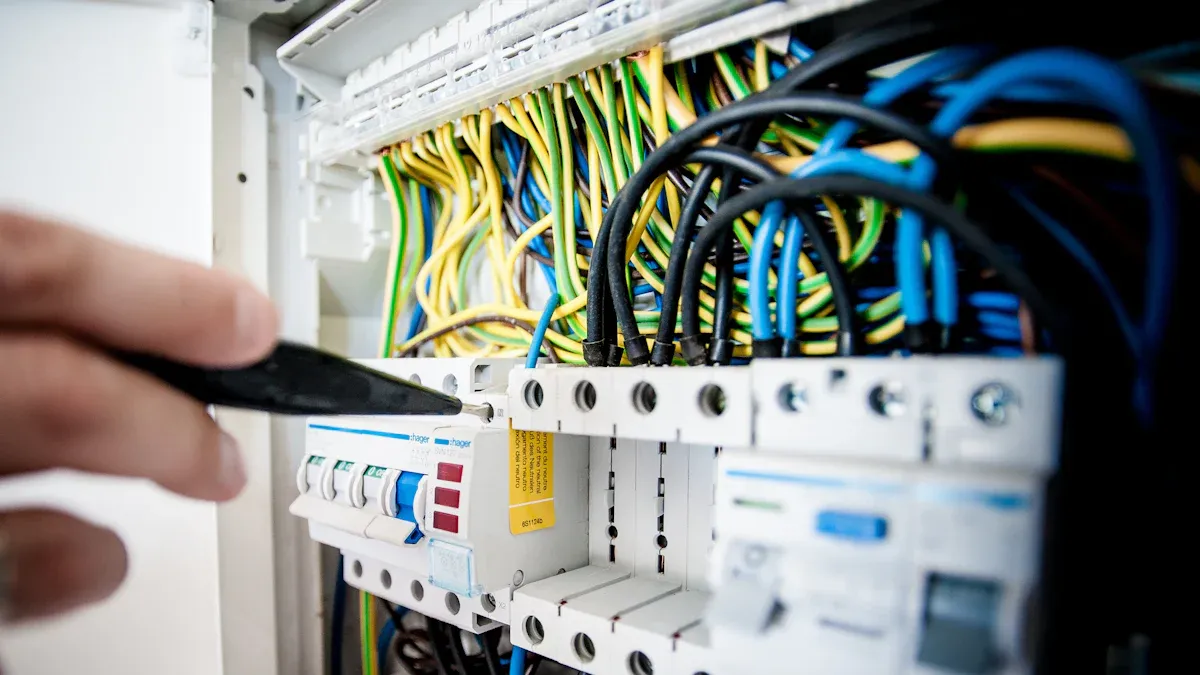Understanding Rectifier Power Supply Basics with ESTEL

Rectifiers and power supplies form the backbone of modern electrical systems. They convert alternating current (AC) to direct current (DC), ensuring stable and efficient energy flow. This technology powers industries, consumer electronics, and renewable energy systems. For instance, the rectifier market is projected to grow from 7.24 billion USD in 2024 to 10.5 billion USD by 2035, driven by energy efficiency and automation demands. ESTEL leads this innovation, offering advanced rectifier power supply solutions that meet the evolving needs of industrial and technological applications.
Key Takeaways
Rectifiers change AC into DC, which powers many electronic devices.
Power supplies control voltage and current to keep devices safe and working well.
Picking the right rectifier means looking at efficiency, strength, and upkeep.
ESTEL's rectifiers have smart features like AI and work very efficiently.
Knowing how linear and switching power supplies differ helps you choose better.
Basic Concepts of Rectifiers and Power Supplies
What is a Rectifier
A rectifier is a device that converts alternating current (AC) into direct current (DC). This process, known as rectification, is vital for powering electronic devices that require a stable DC supply. You can think of it as a one-way gate for electricity, allowing current to flow in a single direction. Diodes, the core components of rectifiers, play a crucial role in this transformation. They block the reverse flow of current, ensuring the AC waveform is converted into a pulsating DC signal.
Rectifiers come in various forms, including semiconductors, vacuum tubes, and commutators. Over time, advancements in semiconductor technology have significantly improved their efficiency and reliability. While the rectified output often contains ripples—small disturbances in the DC signal—filter circuits smooth these fluctuations, delivering clean and usable power.
What are Power Supplies
Power supplies are devices that provide electrical energy to other systems or devices. They adjust voltage levels to match the requirements of the connected equipment. For example, a laptop charger lowers the voltage from your wall outlet to a level suitable for your computer.
Power supplies perform two primary tasks: converting AC to DC and regulating voltage. Basic power supplies may send unregulated voltage, which can fluctuate and potentially harm sensitive electronics. Regulated power supplies, on the other hand, stabilize voltage levels, ensuring consistent performance.
Here’s how a typical power supply works:
Incoming power enters the transformer through the primary winding.
Outgoing electricity connects to the secondary winding.
The transformer adjusts the voltage as needed, using electromagnetic induction to ensure safety and compatibility.
Key Functions and Importance
Rectifiers and power supplies are indispensable in modern electrical systems. Rectifiers enable the conversion of AC to DC, which is essential for most electronic devices. Power supplies ensure that devices receive the correct voltage and current, protecting them from damage and optimizing their performance.
These technologies are foundational to countless applications. From industrial machinery to consumer electronics, they keep systems running smoothly. For instance, rectifiers are critical in renewable energy systems, converting solar panel output into usable DC power. Similarly, power supplies are integral to medical equipment, telecommunications, and data centers.
The evolution of these technologies highlights their importance. Early innovations like the dynamo paved the way for steady DC sources, while modern advancements like silicon solar cells and carbon capture technology continue to push boundaries. This progress underscores the significance of rectifiers and power supplies in shaping the future of energy and technology.
How Rectifiers and Power Supplies Work
AC to DC Conversion Explained
The ac to dc conversion is the cornerstone of the rectification process. It transforms alternating current (AC), which periodically reverses direction, into direct current (DC), which flows in a single direction. This conversion is essential for powering most electronic devices, as they require a stable DC supply to function correctly.
The process begins with a diode, a semiconductor device that allows current to flow in only one direction. When AC enters the rectifier circuit, the diode blocks the negative half of the AC waveform, producing a unidirectional signal. This is known as half-wave rectification. For more efficient conversion, full-wave rectifiers use multiple diodes to process both halves of the AC waveform, resulting in a smoother DC output.
To better understand this process, consider the following table:
Aspect | Description |
|---|---|
Process Modeling | Numerical methods model the conversion in current and voltage modes. |
Resulting Waveforms | MATLAB simulations display the commutation process waveforms. |
Diode Function | Diodes convert AC signals into unidirectional signals, producing DC output. |
Controlled Switches | Thyristors adjust output voltage by varying the firing angle. |
Converter Types | Includes single-phase and three-phase converters, such as half-wave and full-wave. |
The full bridge rectifier is a common configuration for AC to DC conversion. It uses four diodes arranged in a bridge to channel electricity in one direction, regardless of the AC input's polarity. This setup ensures a consistent DC output, making it ideal for applications requiring reliable power.
Filtering and Voltage Regulation
After the rectification process, the DC output often contains ripples—small fluctuations in voltage. These ripples can interfere with the performance of sensitive electronic devices. To address this, filtering and voltage regulation come into play.
Filtering involves the use of capacitors, which store and release electrical energy to smooth out the ripples. A capacitor charges during voltage peaks and discharges during voltage dips, creating a more stable DC signal. Inductors may also be used in some circuits to further reduce fluctuations.
Voltage regulation ensures that the output voltage remains constant, even when the input voltage or load conditions change. This is achieved using voltage regulators, which can be linear or switching. Linear regulators provide a steady output by dissipating excess energy as heat, while switching regulators use high-frequency electronic switches to maintain efficiency.
Tip: A well-designed rectifier power supply combines effective filtering and robust voltage regulation to deliver clean, stable power for your devices.
Components Involved in the Process
Several key components work together to achieve efficient AC to DC conversion and voltage regulation. These include:
Diodes: The primary components responsible for rectification. High-voltage diodes are particularly important for converting AC to DC in industrial applications.
Capacitors: Used for filtering, they smooth out voltage ripples to produce a stable DC output.
Transformers: Adjust the input voltage to a suitable level before rectification.
Voltage Regulators: Maintain a consistent output voltage, protecting devices from fluctuations.
Thyristors: Controlled switches that allow you to vary the output voltage by adjusting the firing angle.
The following table summarizes the functions and applications of these components:
Aspect | Description |
|---|---|
Function | Converts AC to DC, essential for various electronic devices and systems. |
Components | Includes diodes, capacitors, transformers, and voltage regulators. |
Types of Rectifiers | Covers half-wave, full-wave, bridge, and polyphase rectifiers. |
Practical Uses | Found in telecommunications, medical devices, and renewable energy systems. |
Understanding these components and their roles helps you appreciate the complexity and precision involved in designing rectifier power supplies. Whether you're powering a smartphone or a large industrial machine, these elements ensure reliable and efficient operation.
Types of Rectifiers and Power Supplies

Types of Rectifiers (Half-Wave, Full-Wave, Bridge)
Rectifiers are categorized based on their design and performance. The most common types of rectifiers include the half wave rectifier, full wave rectifier, and bridge rectifier. Each type serves specific applications and offers unique advantages.
Half-Wave Rectifier:
This rectifier uses a single diode to convert only one half of the AC waveform into DC. It is simple and cost-effective but has low efficiency. The output voltage is pulsating, making it suitable for basic power supplies.Full-Wave Rectifiers:
These rectifiers utilize both halves of the AC waveform, resulting in higher efficiency and smoother DC output. The center-tap rectifier is a common type of full wave rectifier. It uses a transformer with a center-tapped secondary winding and two diodes. This design is ideal for general electronics requiring moderate power.Bridge Rectifier:
The bridge rectifier employs four diodes arranged in a bridge configuration. It converts the entire AC cycle into DC without needing a center-tapped transformer. This type offers the highest efficiency and smoothest output, making it perfect for high-performance applications like industrial control systems and power adapters.
Rectifier Type | Efficiency | Output Voltage Characteristics | Applications |
|---|---|---|---|
Half-Wave Rectifier | Low | Pulsating DC | Simple power supplies |
Full-Wave Rectifier | Moderate | Smoother DC | General electronics |
Bridge Rectifier | High | Higher and smoother DC | High-performance power supplies |
Note: Bridge rectifiers are widely used due to their ability to utilize the entire AC cycle, providing stable power for sensitive devices.
Types of Power Supplies (Linear, Switching)
Power supplies are classified into two main types: linear and switching. Each type has distinct characteristics and applications.
Linear Power Supplies:
These power supplies use linear regulators to provide a steady output voltage. They are known for their low noise and are commonly used in communication equipment, medical devices, and laboratory testing tools. However, they are less efficient and bulkier compared to switching power supplies.Switching Power Supplies:
Switching power supplies are designed for high efficiency and compactness. They use pulse width modulation (PWM) to regulate output voltage, minimizing energy loss. These power supplies are ideal for high-power applications, such as manufacturing and testing environments.
Feature | Linear Power Supply | Switching Power Supply |
|---|---|---|
Efficiency | Lower due to heat loss | Higher with minimal losses |
Size | Large and heavy | Small and light |
Noise | Low | High |
Cost | Lower for small power | Lower for high power |
Key Components of Rectifier Power Supplies
Rectifier power supplies rely on several key components to ensure efficient operation:
Diodes: Essential for rectification, converting AC to DC.
Transformers: Adjust input voltage to a suitable level for rectification.
Capacitors: Smooth out voltage ripples, ensuring a stable DC output.
Linear Regulators: Maintain a consistent output voltage, protecting devices from fluctuations.
Thyristors: Allow control over output voltage by adjusting the firing angle.
Component Type | Key Features | Reliability Aspects |
|---|---|---|
AC/DC Converter | High energy efficiency, integrated solutions | Reduces design variability, enhances robustness |
CoolSET Integrated Power Stages | Integration of CoolMOS P7 MOSFETs | Improved performance, lower power consumption |
GaN-based Converters | Up to 95% efficiency | Combines multiple circuits into one package |
Understanding these components helps you appreciate the precision involved in designing rectifier power supplies. Whether you're powering a small device or a large industrial system, these elements ensure reliable and efficient performance.
Applications and Benefits of Rectifier Power Supplies

Industrial and Commercial Applications
Rectifier power supplies play a vital role in industrial and commercial settings. They ensure reliable power conversion for heavy machinery, automation systems, and renewable energy installations. For example, the Series 50 Rectifier, as highlighted in the Trystar case study, demonstrates exceptional performance and reliability in industrial scenarios.
Case Study | Description |
|---|---|
Trystar Case Study – Rectifiers | This case study outlines the applications and benefits of the Series 50 Rectifier in various industrial scenarios, showcasing its performance and reliability. |
In manufacturing, rectifier circuits provide stable DC output for welding equipment and electroplating processes. In renewable energy, they convert solar or wind-generated AC into usable DC power. These applications highlight the importance of rectified DC power supply systems in maintaining operational efficiency and reducing downtime.
Consumer Electronics and Everyday Use
In consumer electronics, rectifier power supplies ensure devices operate efficiently and last longer. The growing demand for connected devices, such as IoT gadgets and smart appliances, has increased the need for innovative rectifier designs. These designs meet specific energy requirements while supporting sustainability goals.
The RF Components Rectifier Consumer Electronic Market is expanding due to advancements in technology and the rise of connected devices.
Efficient power management solutions enhance product performance and longevity.
IoT devices and smart appliances require rectifier circuits for precise power regulation.
Companies focus on eco-friendly products to reduce their carbon footprint.
From smartphones to home automation systems, regulated power supplies ensure consistent performance. They protect sensitive electronics from voltage fluctuations and deliver a stable DC output, crucial for modern devices.
Advantages of ESTEL Rectifier Power Supplies
ESTEL’s rectifier power supplies stand out due to their advanced features and superior performance. Their ultra-modular designs allow easy scalability, while AI integration enables predictive analytics and self-optimization. These features ensure efficient operation across various applications, including automotive and industrial automation.
Feature | ESTEL’s Delta Rectifier Modules | Competitors’ Modules |
|---|---|---|
Modularity | Ultra-modular designs | Limited modular options |
AI Integration | Predictive analytics & self-optimization | Basic AI capabilities |
Conversion Efficiency | >98% | 94–96% |
Applications | Automotive, hybrid vehicles, industrial automation solutions | Primarily automotive |
With a conversion efficiency exceeding 98%, ESTEL’s rectifier power supplies outperform competitors. Their ability to deliver a stable DC output ensures optimal performance in critical applications. Whether you need a linear regulated power supply or a switched-mode power supply, ESTEL offers solutions tailored to your needs.
Comparing Rectifiers and Power Supplies
Pros and Cons of Rectifier Types
Rectifiers offer essential functionality in converting AC to DC power, but each type has its strengths and limitations. Understanding these can help you choose the right solution for your needs.
Advantages of Rectifiers:
Converts AC to DC power for electronic devices and battery charging.
Enables efficient HVDC power transmission over long distances.
Provides stable DC power for precision applications like signal processing.
Integral in renewable energy systems, converting variable AC to DC.
Cost-effective and reliable for a wide range of applications.
Disadvantages of Rectifiers:
Generates harmonics and electrical noise during conversion.
Requires additional filtering components to reduce output ripple.
Efficiency decreases at partial loads or away from design conditions.
High initial costs for certain types and associated equipment.
Maintenance may be needed, especially in industrial applications.
Tip: When selecting a rectifier, consider the application’s power requirements and environmental conditions to balance efficiency and cost-effectiveness.
Linear vs. Switching Power Supplies
Linear and switching power supplies differ significantly in design and performance. Comparing their metrics can help you identify the best option for your application.
Metric | Linear Power Supply | Switching Power Supply |
|---|---|---|
Efficiency | Lower efficiency, higher operational costs | Higher efficiency, lower operational costs |
Size | Generally larger due to heat dissipation | More compact due to advanced design |
Noise Levels | Low noise, ideal for sensitive applications | Higher noise, may require filtering |
Cost | Lower manufacturing cost | Higher manufacturing cost but lower long-term costs |
Application Suitability | Best for analog systems and medical equipment | Best for high-power and real-time applications |
Linear power supplies excel in applications requiring low noise, such as medical equipment and analog systems. Switching power supplies, with their compact design and high efficiency, are ideal for high-power environments like industrial automation.
Note: If your priority is energy efficiency and compactness, switching power supplies are the better choice. For sensitive applications, linear power supplies provide superior noise control.
Choosing the Right Rectifier Power Supply with ESTEL
Selecting the right rectifier power supply involves evaluating efficiency, durability, and cost-effectiveness. ESTEL’s solutions stand out due to their advanced features and robust designs.
Key Selection Criteria:
Efficiency: High ratings above 95% minimize energy losses and operational costs.
Durability: Reliable operation in extreme conditions enhances longevity.
Maintenance: Modular designs simplify component replacement, reducing downtime.
Power Capacity: Models cater to diverse operational needs, from small devices to industrial systems.
ESTEL’s rectifier power supplies also feature advanced control mechanisms for optimal power delivery and fault-tolerant designs for enhanced reliability. Their tool-less access ensures easy maintenance, making them ideal for industries requiring uninterrupted operation.
Callout: With ESTEL, you gain access to cutting-edge technology that combines efficiency, durability, and ease of use, ensuring your power supply needs are met with precision.
Rectifiers and power supplies are vital for modern electrical systems. They ensure devices operate safely by adjusting voltages and converting AC to DC power. Without these technologies, most electronic systems would fail to function effectively.
ESTEL leads the way in innovative rectifier power supply solutions. Their energy-efficient rectifiers reduce power loss, while advanced monitoring systems optimize performance. Customizable designs ensure compatibility with diverse telecom devices.
Feature | Description |
|---|---|
Advanced Monitoring Systems | Provides real-time data on performance, helping to identify inefficiencies and optimize operations. |
Energy-Efficient Rectifiers | Designed to operate efficiently, reducing energy loss during the conversion process. |
Customizable Solutions | Tailored to meet diverse telecom needs, ensuring compatibility with various telecom devices. |
Explore ESTEL’s offerings to find reliable, efficient solutions for your power supply needs.
FAQ
1. What is the difference between a rectifier and a power supply?
A rectifier converts AC to DC, while a power supply provides regulated voltage and current to devices. Rectifiers focus on conversion, whereas power supplies ensure stability and compatibility for connected equipment.
2. Why are rectifiers important in renewable energy systems?
Rectifiers convert variable AC output from renewable sources like wind turbines or solar panels into stable DC power. This ensures compatibility with storage systems and electronic devices.
3. How do I choose the right rectifier for my application?
Consider your power requirements, efficiency needs, and environmental conditions. ESTEL offers modular designs and high-efficiency rectifiers tailored to diverse applications.
4. What makes ESTEL rectifier power supplies unique?
ESTEL combines advanced features like AI integration, ultra-modular designs, and >98% efficiency. These innovations ensure reliability, scalability, and optimal performance across industries.
5. Can switching power supplies replace linear power supplies?
Switching power supplies excel in efficiency and compactness, but linear power supplies offer low noise for sensitive applications. Choose based on your device’s requirements and operational priorities.
See Also
Ensuring Correct Voltage Levels in ESTEL Communication Cabinets
Understanding the Power System of ESTEL Telecom Cabinets
An Introductory Guide to Telecom Power Supply Systems
Utilizing Energy Storage Batteries in ESTEL Telecom Cabinets
Methods for Calculating Telecom Cabinet Power and Battery Needs
CALL US DIRECTLY
86-13752765943
3A-8, SHUIWAN 1979 SQUARE (PHASE II), NO.111, TAIZI ROAD,SHUIWAN COMMUNITY, ZHAOSHANG STREET, NANSHAN DISTRICT, SHENZHEN, GUANGDONG, CHINA


